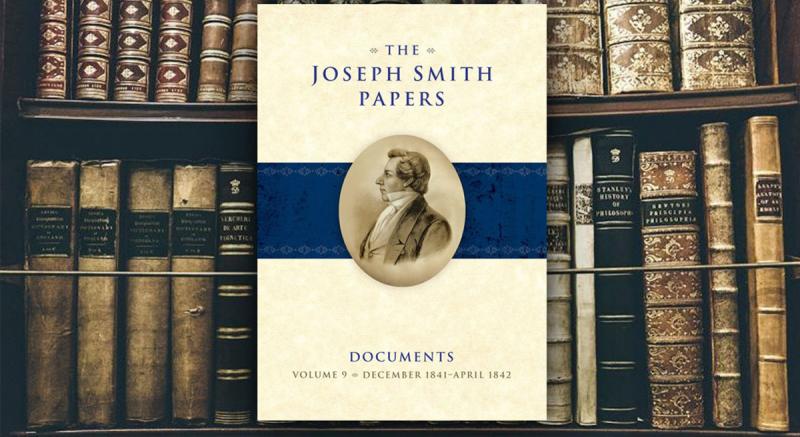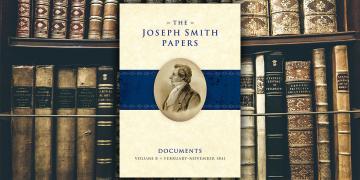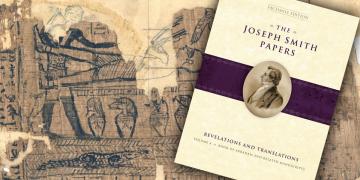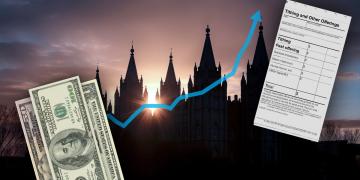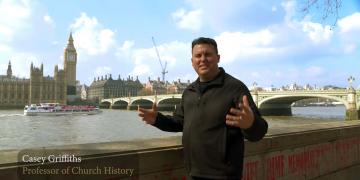You are here
Book of Mormon Central is in the process of migrating to our new Scripture Central website.
We ask for your patience during this transition. Over the coming weeks, all pages of bookofmormoncentral.org will be redirected to their corresponding page on scripturecentral.org, resulting in minimal disruption.
A new volume of the Joseph Smith Papers Project has been published and is available for purchase from Deseret Book and other online retailers. Documents, Volume 9: December 1841–April 1842, edited by Alex D. Smith, Christian K. Heimburger, and Christopher James Blythe, includes important documents and papers from the Prophet Joseph Smith that signify the many evolving roles the Prophet undertook during this period. “The documentary record from these winter months shows a measurable increase in Smith’s record keeping—a trend that continued in the few remaining years of his life,” write the editors in the volume’s introduction. “The newly formed municipal and religious organizations in which Joseph Smith played some role generated a significant body of minutes, financial ledgers, and other institutional documents. And as Smith’s own responsibilities grew in number and variety, his documentary output increased commensurately.”1
While letters, quorum and municipal government minutes, and financial papers are featured in this new volume, Documents, Volume 9 also includes a number of important documents that touch on Joseph Smith’s roles as prophet and revelator for The Church of Jesus Christ of Latter-day Saints. As explained by the volume editors:
[I]n January 1842 Smith dictated a brief revelation directing the Quorum of the Twelve Apostles to take over editorial control of the Times and Seasons. . . . Acquiring the church’s official organ for communicating with its members—which, at the time, was also the city’s sole newspaper—resulted in additional responsibilities for Joseph Smith. Although apostles John Taylor and Wilford Woodruff oversaw the day-to-day operation of the printing establishment, Smith assumed editorship with the 1 March issue and continued in that role through October. While Smith’s level of involvement as editor of the paper fluctuated during his eight-month tenure and was at times superficial, the paper bore his name and implied endorsement. . . . A few of the editorials that Joseph Smith was involved in authoring during this period are particularly noteworthy. In the 1 March 1842 issue of the Times and Seasons, Smith published a narrative account of the church’s history reportedly solicited by Chicago Democrat editor John Wentworth. In addition to providing an important description of Joseph Smith’s first vision of Deity, this account, titled “Church History,” included a section presenting thirteen statements of belief that were later canonized as the church’s “Articles of Faith.” In the same issue of the paper, Smith began publishing serial installments of “The Book of Abraham,” an account of the biblical patriarch Abraham that Smith began dictating following the purchase of ancient Egyptian papyri in 1835 (this text was also later canonized). . . . Finally, the 1 April 1842 issue of the paper included a lengthy article titled “Try the Spirits”—warning church members against false prophets and counterfeit gifts of the Spirit—which Joseph Smith likely wrote, providing a rare example of his direct involvement in authorship of editorial content.2

Editor and historian Alex D. Smith exhibiting some of the documents featured in Documents, Volume 9 of the Joseph Smith Papers.
In addition to providing the basis for what would later become the Articles of Faith in the Pearl of Great Price, the so-called Wentworth Letter, or the “Church History” editorial, is significant for preserving one of the few firsthand descriptions of Joseph Smith’s First Vision as well as the Book of Mormon plates:
These records were engraven on plates which had the appearance of gold, each plate was six inches wide and eight inches long and not quite so thick as common tin. They were filled with engravings, in Egyptian characters and bound together in a volume, as the leaves of a book with three rings running through the whole. The volume was something near six inches in thickness, a part of which was sealed. The characters on the unsealed part were small, and beautifully engraved. The whole book exhibited many marks of antiquity in its construction and much skill in the art of engraving. With the records was found a curious instrument which the ancients called “Urim and Thummim,” which consisted of two transparent stones set in the rim of a bow fastened to a breastplate. Through the medium of the Urim and Thummim I translated the record by the gift, and power of God.3
The organization of the Nauvoo Masonic lodge and the Female Relief Society of Nauvoo were both initiated during this period (on March 15–16 and March 17, 1842, respectively). “Though Joseph Smith did not initiate the creation of either organization, he endorsed the formation of and participated in both (but was much more directly involved in the organization of the Relief Society),” explain the volume editors. Documents pertaining to the formation of these two important Nauvoo institutions are reproduced in Documents, Volume 9 with helpful contextual historical commentary. “The installation of the Nauvoo lodge and the creation of the Relief Society two days later were significant and related,” explain the editors.
Both organizations taught virtue and required moral uprightness for membership. Freemasonry emphasized the need to safeguard the sacred—a principle Joseph Smith repeatedly taught to the Relief Society (even referring to the society’s members as Masons on one occasion). The Relief Society, in particular, offered Smith a venue for giving instruction to trusted church members that would prepare the Saints for the “endowment” ceremony that he unfolded to a small group of church members only weeks later, in early May 1842. The formation of these organizations was an important step for the doctrinal and cultural development of the ever-expanding community.4
In addition to the (re)publication of revelations, translations, and doctrinal commentaries, Documents, Volume 9 highlights the few surviving records preserving some of the sermons or discourses delivered by Joseph Smith. One of these discourses was delivered on January 30, 1842 and touches on the topic of “deification and other doctrines.”5 Preserved in the handwriting of Wilford Woodruff, the notes recording this discourse include explicit mention of themes and teachings that the Prophet would later emphasize in his April 7, 1844 “King Follett Sermon.”
Joseph the Seer taught the following principles that the God & father of our Lord Jesus Christ was once the same as the Son or Holy Ghost both having redeemed a world became the eternal God of the world he had a son Jesus Christ who redeemed a world became the eternal God of that world which made them equal & the Holy Ghost would do the same in his turn & so would all the Saints who inherited a Celestial glory so their would be Gods many & Lords many…6
Commentary provided by the editors helps accurately situate the Prophet’s teachings about deification and the potential exaltation of God’s children in their historical context:
Deification, as a Latter-day Saint doctrine, appeared in the vision of the afterlife that [Joseph Smith] and Sidney Rigdon experienced on 16 February 1832 [Doctrine and Covenants 76]. Their account of the vision referred to postmortal human inhabitants of the celestial kingdom–the highest of three kingdoms of heavenly glory–as “Gods even the sons of God.” Parley P. Pratt defended the concept in a pamphlet printed in 1838. In 1841, Thomas Sharp–a Warsaw, Illinois, newspaper editor who was hostile to the church–responded, claiming “the reasoning of the Apostle Parley P. Pratt” and “the doctrine of the Church” to be that Latter-day Saints would “have power to create worlds” in the next life “and that those worlds will transgress the law given, consequently they will become saviors to those worlds, and redeem them; never, until all this is accomplished, will their glory be complete; and then there will be ‘Lords many and Gods many.’” This statement contains similarities with the [January 30, 1842 discourse], suggesting that Sharp was drawing on existing beliefs among the Latter-day Saints. In the sermon featured here, [Joseph Smith] further elucidated his previous teachings regarding deification and related subjects.7
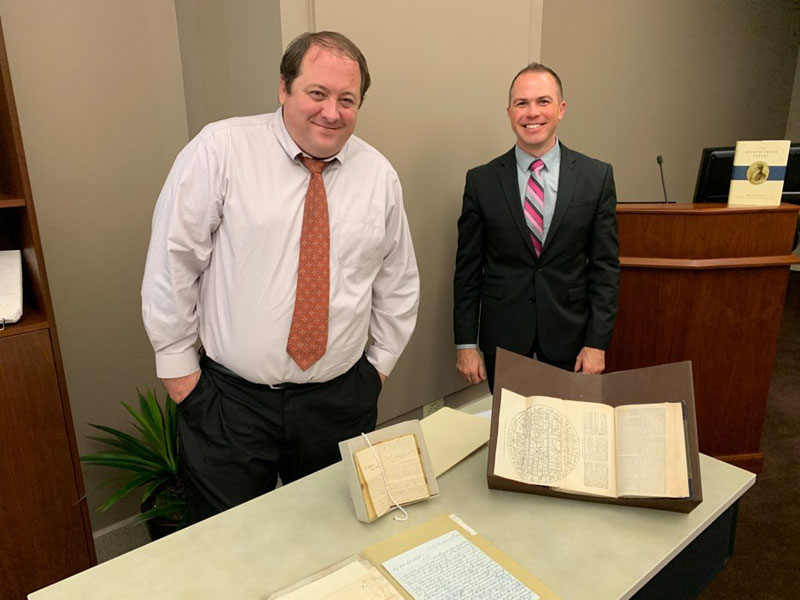
Editors and historians Christian K. Heimburger, right, and Christopher James Blythe, left, exhibiting some of the documents featured in Documents, Volume 9 of the Joseph Smith Papers.
As with the previous volumes of the Joseph Smith Papers Project, Documents, Volume 9 offers a treasure-trove of primary sources for those interested in studying the history of the Church and the life of the Prophet. “In these brief five months in 1841 and 1842, Joseph Smith remained in Nauvoo, hardly venturing outside the city. But it was a period of intense activity as he helped found the Relief Society, took on new professional responsibilities in editing a paper and managing a store, and instructed church members near and far through discourses and letters. The documents in this volume are vital to understanding Joseph Smith’s life and the church’s growth and development during this period.”8
At the moment, most of the documents printed in this volume can be accessed for free on the Joseph Smith Papers website. Eventually all of the documents featured in this volume will be made accessible online.
Related Articles
- 1. Alex D. Smith, Christian K. Heimburger, and Christopher James Blythe, eds., The Joseph Smith Papers, Documents, Volume 9: December 1841–April 1842 (Salt Lake City, UT: The Church Historian’s Press, 2019), xix–xx.
- 2. Smith, Heimburger, and Blythe, eds., Documents, Volume 9, xxii–xxiii.
- 3. “Church History,” Times and Seasons 3, no. 9 (March 1, 1842): 707, in Smith, Heimburger, and Blythe, eds., Documents, Volume 9, 182–183.
- 4. Smith, Heimburger, and Blythe, eds., Documents, Volume 9, xxvi.
- 5. Smith, Heimburger, and Blythe, eds., Documents, Volume 9, 128.
- 6. Discourse, 30 January 1842, in Smith, Heimburger, and Blythe, eds., Documents, Volume 9, 129.
- 7. Smith, Heimburger, and Blythe, eds., Documents, Volume 9, 128.
- 8. Smith, Heimburger, and Blythe, eds., Documents, Volume 9, xxix.
Subscribe
Get the latest updates on Book of Mormon topics and research for free


